Long before parking became Manayunk's modern nightmare, urban planners had to contend with the steep terrain that separated residents up the hill in Roxborough from the bustling industrial corridor that sprouted along Main Street in the 19th century.
The rocky ridge that runs northwest from the meeting of the Schuylkill River and the Wissahickon Creek made it treacherous for workers, students and churchgoers to navigate.
MORE: King of Prussia home designed by renowned architect Richard Neutra hits market for $2.5 million
"You had your mills down in Manayunk and you had your mill owners, workers and store clerks up the hill in Roxborough," Georgie Gould, president and archivist at the Roxborough Manayunk Wissahickon Historical Society, said of the divided landscape. "There were no cars, no trains, no trolleys. It was horse or foot, that was it."
Records in the years after the Civil War show work began on a series of staircases connecting inaccessible parts of the neighborhoods. The earliest were built with wood, and later metal, before concrete was added to make the steps more durable. Over the course of several decades, more than a dozen staircases were constructed along a roughly 2-mile stretch that runs northwest from the junction of the river and the creek.
"The stairs symbolized just how joined these communities were," Gould said. "I can look at any map and find the same surname on either side of a set of steps, and the only way to get to each other would have been either to go up the street in the mud, around the horses and carts and buggies, or take the steps. It was a footpath highway getting down the hill."
 Jon Tuleya/PhillyVoice
Jon Tuleya/PhillyVoice
The Jamestown Avenue steps cut a path through the trees and brush between Tower and Terrace streets in Manayunk.
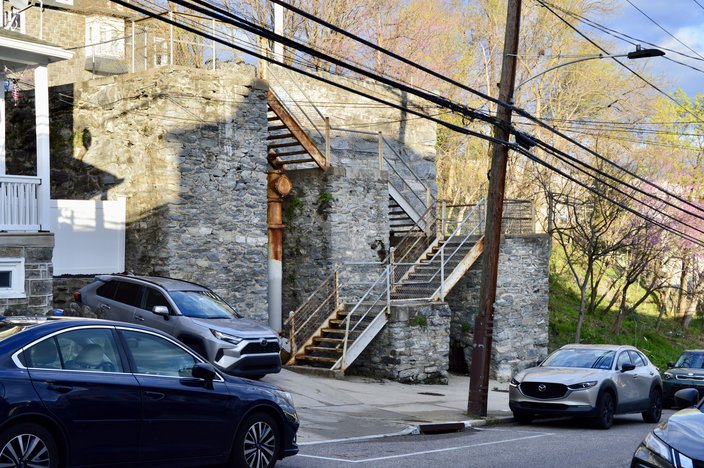 Jon Tuleya/PhillyVoice
Jon Tuleya/PhillyVoice
These are the stairs at the end of Wendover Street known as the Castle Steps because the stone structure that supports them looks like a castle wall.
The stairs that carve through Manayunk and Roxborough are appreciated today for their sweeping views and gauntlets of fitness, including a cameo for the DuPont Street steps in Adam Sandler's 2022 Netflix movie "Hustle."
Collectively, the staircases add up to the 1,304 steps. The locations of each set of steps can be found using this interactive map made by the historical society. The largest staircase, from Gay Street down to Silverwood Street, has 132 steps. Among the smallest are the 41 steps from Dexter Street down to East Street.
"They're all still vital to the community, and not just as a means of getting by," Gould said. "There's a sense of identity. People remember going up and down those stairs with their grandparents."
Inspecting and maintaining staircases
Keeping the aging steps of Roxborough and Manayunk safe and sturdy poses challenges for the city to prioritize which are most in need of repairs.
At the beginning of April, the Philadelphia Department of Streets started work to rehabilitate the Roxborough Avenue staircase that connects Boone and Terrace streets near Pretzel Park. In addition to demolishing and repairing some of the stairs and piers, crews will fix a retaining wall on Boone Street and resurface the road. The staircase will remain closed for several months during the $1.3 million project.
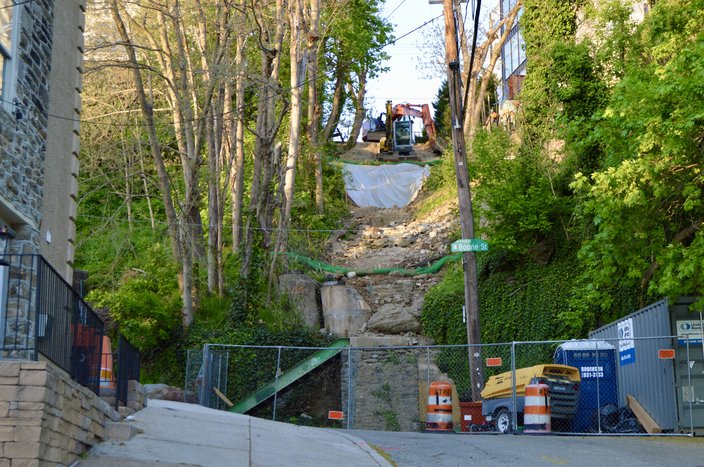 Jon Tuleya/PhillyVoice
Jon Tuleya/PhillyVoice
Repairs are underway on the Roxbrough Avenue steps, shown here at the base of the stairs where they connect with Boone Street.
The Streets Department is responsible for inspecting and maintaining a total of 19 staircases in Philly, including 16 in Roxborough and Manayunk. Those that connect to parks are owned and maintained by Philadelphia Parks & Recreation, while others are owned by SEPTA and PennDOT.
With help from the Delaware Valley Regional Planning Commission, the Streets Department is conducting a planning study of city-owned staircases in Roxborough and Manayunk. The goal is to determine which are used most heavily and develop schedules for fixing those that need work.
"This will include counts of stairway users to better understand how they are being used," Streets Department spokesperson Chris Young said.
The city has made repairs to two other staircases in the area over the last decade – the pair that connects Krams Avenue and Silverwood Street – and is now in the design phase for rehabilitation of the Gay Street steps.
'You have to get nasty with the city'
Sometimes, residents have had to fight to get the city to maintain and fix the stairs in Roxborough, Manayunk and the smaller residential enclave of Wissahickon.
The most scenic and well-known stairs – the zig-zagged 100 Steps at Wissahickon Valley Park – were last repaired in the early 2000s after years of neighbors complaining about deterioration, vandalism, trash and loitering teenagers. The granite stairs, originally built in 1901, are a hallmark of the area's natural charm with sweeping views of the creek and a paved path that connects to the surrounding trail network.
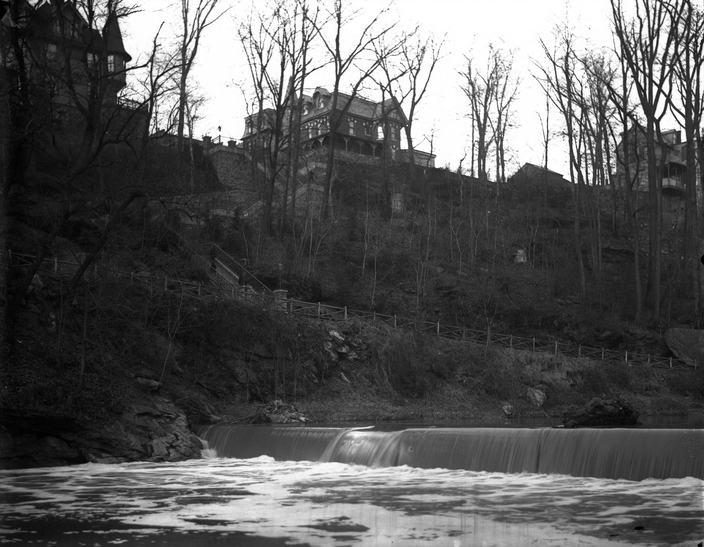 Provided Image/Library Company of Philadelphia
Provided Image/Library Company of Philadelphia
A view of the 100 Steps from the Wissahickon Creek is shown above in 1907 in a photograph taken by Frank Berry. A small waterfall is visible in the foreground and large houses along Freeland Avenue are perched on the hill overlooking the creek.
Chip Roller, the former president of the Wissahickon Interested Citizens Association, recalled having to pull strings at City Hall to deal with the problems at the 100 Steps in the 1970s and '80s. To get rid of an abandoned car and shut down a nearby brothel in the neighborhood, Roller recalled neighbors reaching out to Al Pearlman – a City Council member and close friend of former Mayor Frank Rizzo – to intervene directly.
"That's the kind of thing we had to do before 311," Roller said. "It wasn't just calls. It was elbows. Sometimes you have to get nasty with the city to get them to do anything."
Roller, 82, said he used to ride his bike home from Center City and carry it up the 100 Steps when he was younger. He's held onto newspaper clippings from when the city was preparing to rehab the scenic staircase, including an Inquirer article that discussed the teenage "cocktail hour" that had become a nightly nuisance there.
"The handful of kids sharing a six-pack can grow to a dozen or more draining a keg," the article said. "And their fun can include smoking marijuana, playing loud music and occasionally destroying property."
In addition to organizing trash cleanups, Roller said he and his neighbors collected damaged capstones and vandalized railings to preserve them for the eventual restoration of the 100 Steps. The project, which used the original specifications of the staircase, was completed in late 2004 and dedicated by Michael Nutter, who was the council member representing the neighborhood, the next spring. The city spent a combined $309,000 for design and construction at the time.
"The fact the neighbors there saved the various pieces to be used again shows a real dedication and affection for those steps," Roller said.
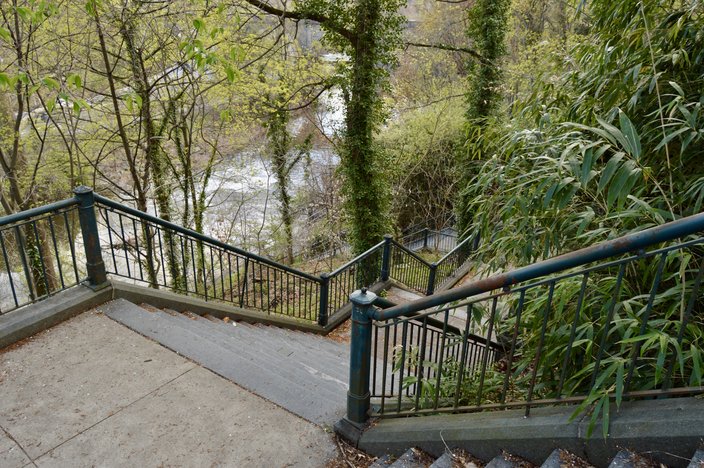 Jon Tuleya/PhillyVoice
Jon Tuleya/PhillyVoice
A view of Wissahickon Creek from the nearby 100 Steps.
Steps became social, recreational gateway across eras
The staircases of Roxborough and Manayunk are among Philadelphia's most unique urban features in a city that has no shortage of sightseeing to boast. Some of them overlook the gorgeous scenery of Manayunk's stone bridges, the towpath along the canal and the homes that dot the hillsides. Others are simply there to fulfill a utilitarian function in a place that remains tough to navigate, even with the convenience of cars and public transit.
At the Roxborough Manayunk Wissahickon Historical Society, Gould maintains a webpage that celebrates the 1,304 steps and reflects on their value to the surrounding communities. Former RMWHS president and lifelong Roxborough resident Hilma Larkin ventured to climb and photograph them all in the early 1990s – when she was in her 70s – and reminisced about her experience growing up using the steps in a 1992 article published by the Philadelphia Daily News.
"My younger sister Ethel and I would sneak down to Manayunk on Saturday afternoon to see what was going on," Larkin told the Philadelphia Daily News. "We sneaked down because we weren't supposed to go away from our neighborhood. I remember we'd go to a 5 & 10 with a squeaky wooden floor on Main Street."
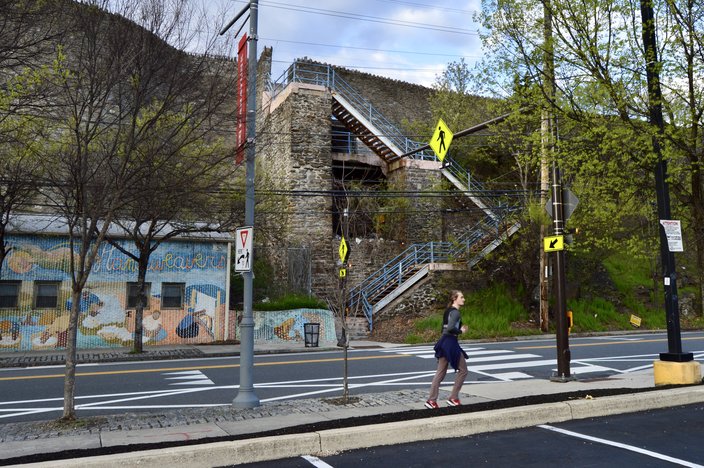 Jon Tuleya/PhillyVoice
Jon Tuleya/PhillyVoice
The steps connecting Ridge Avenue with Main Street in Manayunk. These stairs are located across from the Regal UA Main Street movie theater.
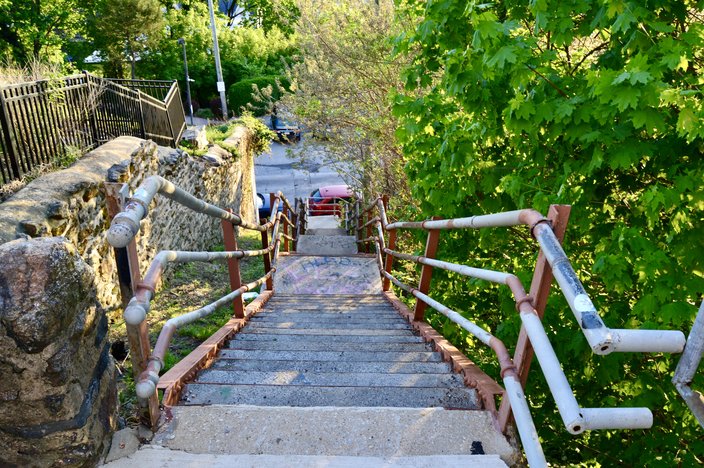 Jon Tuleya/PhillyVoice
Jon Tuleya/PhillyVoice
The view looking down Manayunk's Grape Street steps. These stairs connect Boone Street to Tower Street.
Gould said the steps played a crucial roll in the transformation of Main Street from an industrial area lined with textile mills and factories to one that also supported retail stores serving Roxborough residents.
"The stairs were absolutely something that tied the neighborhoods together," Gould said.
And as the decades passed, the steps became a social gateway.
Virginia Buchanan, an RMWHS member who grew up taking the steps in the 1970s, recalled using them with friends to go to the movies and dances on weekends. She said the steps had a way of leaving their mark on people from Manayunk and Roxborough.
"You could always tell the women from the area because they had nice calves," Buchanan said.